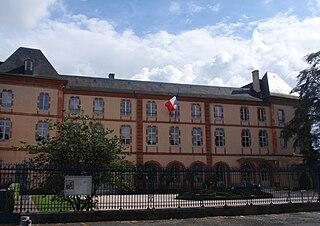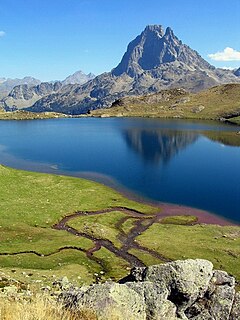
The Pyrénées National Park is a National Park of France located within the French departments of Hautes-Pyrénées and Pyrénées-Atlantiques.

Roland's Breach is the name of a natural gap, 40 m across and 100 m high, at an elevation of 2804 m in the Pyrenees on the border of Aragón, northern Spain, and Hautes-Pyrénées, France.

Monte Perdido is the third highest mountain in the Pyrenees. The summit of Monte Perdido (3355 m), located in Spain, lies hidden from France by the seemingly impenetrable peaks of the Cirques of Gavarnie and Estaubé. It stands in the north of Huesca province. The mountain forms part of the Monte Perdido Range and is located in the Ordesa y Monte Perdido National Park, in the western part of the Pyrenees, in the community of Aragon, Spain.

The Ordesa Valley is a glacial valley in Aragon, in the Spanish Pyrenees which forms part of the Ordesa y Monte Perdido National Park. It was first discovered in 1820, but not mapped in detail until approximately the 1920s. The valley is about 11 kilometres (7 mi) long.

Soum de Ramond, also known as Pico de Añisclo in Spanish and Aragonese, is a mountain of 3,263 metres in the Monte Perdido massif in the Aragonese Pyrenees in northern Spain. It is one of the three mountains comprising Las Tres Sorores, the others being Monte Perdido and Cilindro de Marboré.
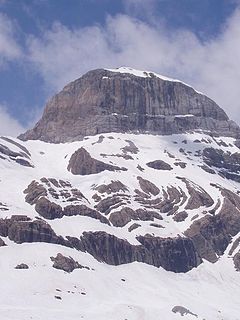
Cilindro de Marboré is a mountain in the Monte Perdido massif in the Pyrenees.

The Pyrénées – Mont Perdu World Heritage Site is a World Heritage site straddling the border between Spain and France in the Pyrenees mountain chain. The summit of Monte Perdido is on the Spanish side of the border. The site was designated in 1997 and extended north in 1999 to include the Commune of Gèdre in France.
Góriz or Refuge of Góriz, is a mountain refuge located in the province of Huesca in the Spanish Pyrenees. The hut is a hub of different treks in the area, like GR 11 or Monte Perdido climb. It can guest 72 people and used to be full so it used to be necessary to book in advance. Its height is 2,195 metres (7,201 ft) and its coordinates are N 42° 39,783′ E 000° 00.911′.
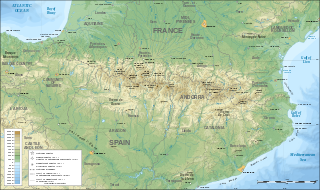
Marboré Peak is a summit in the Pyrenees located on the Franco-Spanish border crest in the Monte Perdido Range.
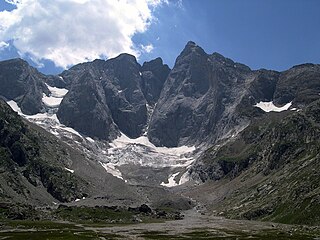
The Clot de la Hount or pic du clot de la Hount is a summit of the Pyrenees, located on the Franco-Spanish border in the Vignemale Massif, of which it is the second highest summit in the range, at 3,289 m, after Pique Longue.

The pic Central is a pyrenean summit, culminating at 3,235 m (10,614 ft), located on the Franco-Spanish border in the massif du Vignemale, of which it constitutes the fourth highest peak.
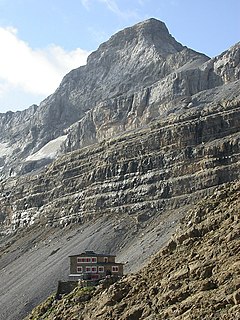
The Casque du Marboré, or Casque de Gavarnie or simply le Casque, is a pyrenean summit, culminating at 3,006 m (9,862 ft), located on the crest of three-thousanders in the Monte Perdido Range above Cirque de Gavarnie on the Franco-Spanish border.
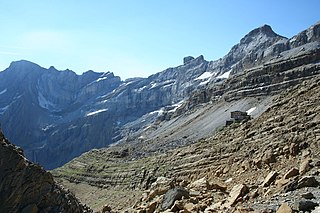
Épaule du Marboré is a pyrenean summit, culminating at 3,073 m (10,082 ft) in the Monte Perdido Range, marking the Franco-Spanish border. It lies on the Greenwich meridien.
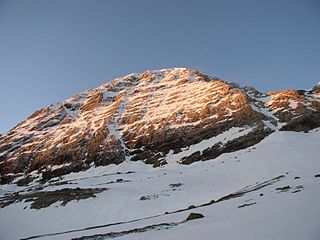
Pic du Taillon or Pico Taillón is a summit in the Pyrenees, culminating at 3,144 m (10,315 ft) on the Franco-Spanish border in the Monte Perdido Range.

The Cascade Peaks are three summits in the Monte Perdido Range of the Pyrenees, culminating at 3,161 m (10,371 ft) on the eastern peak. The central peak, known as Brulle, and the western peak are 3,106 m (10,190 ft) and 3,095 m (10,154 ft) high, respectively. The peaks are located on the 3,000 m French-Spanish borderline crest.

Le refuge des Sarradets, or refuge de la Brèche de Roland is a mountain refuge in the Pyrenees. It is located in Gavarnie, near la brèche de Roland, in the Pyrenees National Park, at 2,587 m (8,488 ft) high.









